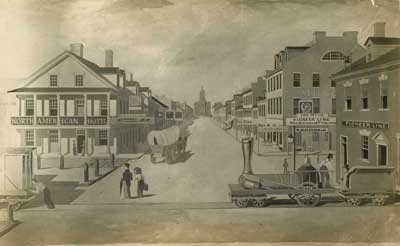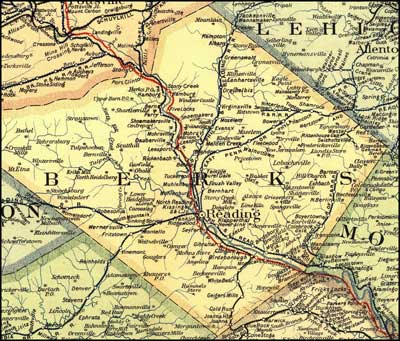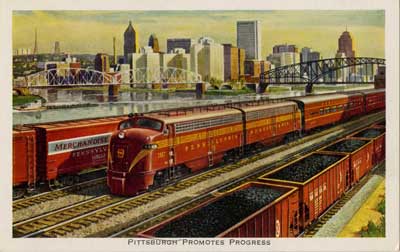Developmental History
Railroad Growth and Development, 1830s-1850s
"Comparatively speaking, the railroad industry started late in Pennsylvania, in part due to the huge investment sunk by the Commonwealth and private investors into the turnpikes and then the Main Line Canal system. After the slow start of the 1830s, Pennsylvania became a national leader in railroad development in the 1840s and 1850s. By 1860 it had surpassed all states in total railroad mileage, a position it would hold into the 20th century.
Railroads initially developed as a means of more economically moving commodities such as minerals and farm goods to market. Yet they were also a function of, and a catalyst for, the state's industrial-based economy. The new dependable, all-weather transportation, in turn, spurred further industrial growth. Freed from dependence upon water-borne transportation, industries grew up in all corners of the state. With new industries, small towns with rail connections grew to urban centers, and other smaller rail towns were founded overnight wherever a railroad company decided to place a depot. Other towns such as Altoona grew specifically to service the railroads with car shops and maintenance yards. The most dramatic growth occurred in iron making and in coal extraction. Iron was spurred by the railroad's demand for metal rails and cars, and coal was the primary fuel for railroads, the metal industries, and home heating throughout the Northeast. In a symbiotic relationship, Pennsylvania railroads carried these products throughout the state and the nation.
 |
|
Drawing of the Lancaster Philadelphia & Columbia Railroad Depot, |
The Age of Railroad Dominance, 1860s-1910s
The leading story of Pennsylvania's transportation from the 1860s to the early 1910s was the dominance of railroads and the extension of rail lines into every corner of the state. The state's railroad industry grew from 2,600 miles of track in 1860 to more than 11,500 miles of track at its peak in 1920. the expansion of Pennsylvania's railroads was not unique but part of a nationwide trend that brought the railroad to the forefront of the American economy. Railroads evolved into the nation's first "big business," assuming control of vast holdings of capital, real estate, equipment, and employees. As they grew in size, the railroads moved to standardize operations, gradually eliminating the multiplicity of gauges that had plagued the industry during the Civil War. In favor of the standard gauge, the new standard gauge of four feet eight and one-half inches, helped the railroads to integrate the many lines into a vast network serving a national market. At the same time, the railroads upgraded their physical plant, replacing iron rails with heavier steel ones, wood and iron bridges with stronger steel and stone spans, wooden cars with steel, and early engines with larger, more powerful varieties.
The railroads had a profound impact on the state's economy and landscape, so much that every major town or city was historically impacted in some way. American iron and steel manufacturers concentrated production at large, integrated plants in selected districts, most notably the Pittsburgh region, on its way to becoming "the steel city." After 1870, rail lines extended south and east from Pittsburgh to rich bituminous coal fields, such as the one centered around Connellsville, location of one of the nation's richest supplies of coking coal, an important fuel source for the iron and steel industry.
As the rail lines opened national markets, thousands of Pennsylvania manufactories, great and small, benefitted from the new markets and availability of new resources. Northeast of Pittsburgh, rail lines extended into the oil fields around the towns of Oil City and Titusville, precipitating the boom in that industry. Logging railroads were a significant technological advance helping loggers reach vast strands of timber in the Allegheny Plateau of northern Pennsylvania. The state was soon known nationally not only for iron and steel, coal and coke, oil and lumber, but also textiles, machine tools, leather, railroad cars, ship buildings, glass, and printing.
 |
|
The Lackawanna Valley by George Inness |
Railroads in the Highway Era, 1920s-1990s
Despite their great success as a transportation system, railroads were always a business of comparatively modest profits. The industry was heavily capitalized, with high fixed costs tied up in essential holdings like rights-of-way, track, bridges, locomotives and cars, stations, warehouses, and other fixed structures. Large land holdings, in turn, subjected the railroad to an equally great property tax load, often this burden increased beyond what could be justified by traffic. Competing lines, which were legion in Pennsylvania, assured that most bulk commodities shipping rates remained comparatively low. Moreover, arcane freight pricing structures did not establish rates strictly based on competition, commodity, and distance but instead used various factors to establish maximum and minimum rate levels. So long as other costs and competition from outside forms of transportation remained static the railroad industry remained profitable. Its position was, however, precarious.
Competition increased from other forms of transportation, particularly private automobiles, trucks, barges, and pipelines. During World War I, more and more shippers, exasperated with railroad car shortages and freight bottlenecks, turned to the nascent trucking industry. After World War I, massive infusions of federal aid helped Pennsylvania and other states build and improve integrated state highway systems.
Years of overbuilding, high-fixed costs, heavy debt loads, and declining business were catching up with the industry. With railroad traffic and profits declining precipitously following World War II, there was no money to spare, and further debt was something few railroads could afford. Pennsylvania's anthracite railroads were among the hardest hit, victims of outside competition, mine depletion, a switch from hard coal to oil as the primary choice in home heating, and the completition of the St. Lawrence Seaway, which syphoned off Great Lakes traffic. The decline of manufacturing and mining in Pennsylvania and the northeast, the lifeblood of the Commonwealth's railroads, sapped the carriers. The railroad companies, led by the Pennsylvania Railroad, reorganized ruthlessly, consolidating shop operations, reducing employment, and abandoning unprofitable branch lines."
Read the remainder of Lichtenstein & Associate's "Historic Context for Transportation Networks in Pennsylvania" (PDF).
See also ExplorePAHistory's "The Railroad In Pennsylvania" websites.
 |
|
Pennsylvania Railroad's "Pittsburgh Promotes Progress" |